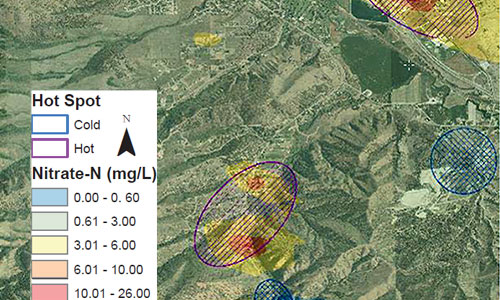

Common Searches
Courtney Ohr, Sarah Godsey, James Stoutenborough, Kathleen Lohse, Donna Lybecker, Danelle Larson, Rebecca Hale, John Welhan, DeWayne Derryberry, Oscar Ebanja, Bailee Nye, Jenna Dohman
City of Pocatello, Idaho Department of Water Quality
To better understand patterns, sources, and perceptions of water contamination at the urban-rural-wildland interface (Lower Portneuf River Valley), our EPSCoR team of social and physical scientists is studying nitrate and pharmaceutical contamination in private and public wells, as well as the public’s perception of risks associated with groundwater contamination.
To accomplish this, we have sampled ~100 private wells and identified hot spots of nitrate contamination using spatial analysis tools. We have analyzed the samples for nitrate, nitrate isotopes, anions, and pharmaceuticals. Septic sources were confirmed or likely sources of contamination for ~60% of the wells studied, contrasting with one narrative of agricultural sources of contamination. We also found that people were most likely to take effective action to treat their water if they had the means to do so, and expressed concern about their water quality. We expect to expand the survey to include respondents outside of city limits in hotspots of nitrate contamination, and to include pharmaceutical testing for public wells.
Water quality in small cities, especially those that rely on groundwater supplies for municipal water uses, can be strongly affected growth patterns. High septic densities associated with growth at the ex-urban boundary can lead to hotspots of water contamination that may outstrip small cities’ resources to mitigate the impact of growth. Our source identification confirmed likely septic impact in most private wells that were sampled. Survey results suggest that risk perception was strongly driven by fear of the unfamiliar threat, relatively new emerging contaminants, such as pharmaceuticals.

